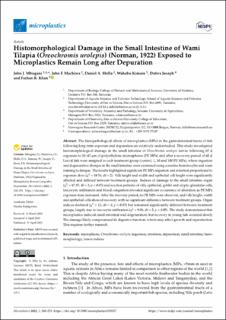| dc.contributor.author | Mbugani, John J. | |
| dc.contributor.author | Machiwa, John F. | |
| dc.contributor.author | Shilla, Daniel Abel | |
| dc.contributor.author | Kimaro, Wahubu | |
| dc.contributor.author | Joseph, Dativa | |
| dc.contributor.author | Khan, Farhan R. | |
| dc.date.accessioned | 2023-03-30T12:24:48Z | |
| dc.date.available | 2023-03-30T12:24:48Z | |
| dc.date.created | 2023-02-03T18:03:10Z | |
| dc.date.issued | 2022 | |
| dc.identifier.citation | Microplastics. 2022, 1 (2), 240-253. | en_US |
| dc.identifier.issn | 2673-8929 | |
| dc.identifier.uri | https://hdl.handle.net/11250/3061184 | |
| dc.description.abstract | The histopathological effects of microplastics (MPs) in the gastrointestinal tracts of fish following long-term exposure and depuration are relatively understudied. This study investigated histomorphological damage in the small intestine of Oreochromis urolepis larvae following 65 d exposure to 38–45 μm of polyethylene microspheres (PE MPs) and after a recovery period of 60 d. Larval fish were assigned to each treatment group (control, 1, 10 and 100 PE MPs), where ingestion and degenerative changes in the small intestine were examined using a routine hematoxylin and eosin staining technique. The results highlighted significant PE MPs ingestion and retention proportional to exposure dose (χ2 = 49.54; df = 2). Villi height and width and epithelial cell height were significantly affected and differed between treatment groups. Indices of damage to the small intestine organ (χ2 = 47.37; df = 2; p < 0.05) and reaction patterns of villi, epithelial, goblet and cryptic glandular cells, leucocytic infiltration and blood congestion revealed significant occurrence of alteration as PE MPs exposure dose increased. After the recovery period, no PE MPs were observed, and villi height, width and epithelial cells showed recovery with no significant difference between treatment groups. Organ indices declined (χ2 = 12; df = 2; p < 0.05) but remained significantly different between treatment groups, largely due to leucocytic infiltration (χ2 = 9.08; df = 2; p < 0.05). The study demonstrated that microplastics induced small intestinal wall degeneration, but recovery in young fish occurred slowly. The damage likely compromised its digestive function, which may affect growth and reproduction. This requires further research. | en_US |
| dc.language.iso | eng | en_US |
| dc.rights | Navngivelse 4.0 Internasjonal | * |
| dc.rights.uri | http://creativecommons.org/licenses/by/4.0/deed.no | * |
| dc.subject | Mikroplast | en_US |
| dc.subject | Microplastic | en_US |
| dc.title | Histomorphological Damage in the Small Intestine of Wami Tilapia (Oreochromis urolepis) (Norman, 1922) Exposed to Microplastics Remain Long after Depuration | en_US |
| dc.title.alternative | Histomorphological Damage in the Small Intestine of Wami Tilapia (Oreochromis urolepis) (Norman, 1922) Exposed to Microplastics Remain Long after Depuration | en_US |
| dc.type | Peer reviewed | en_US |
| dc.type | Journal article | en_US |
| dc.rights.holder | © 2022 by the authors | en_US |
| dc.description.version | publishedVersion | en_US |
| cristin.ispublished | true | |
| cristin.fulltext | original | |
| cristin.qualitycode | 1 | |
| dc.identifier.doi | 10.3390/microplastics1020017 | |
| dc.identifier.cristin | 2122940 | |
| dc.source.journal | Microplastics | en_US |
| dc.source.volume | 1 | en_US |
| dc.source.issue | 2 | en_US |
| dc.source.pagenumber | 240-253 | en_US |
| dc.relation.project | Andre: WIOMSA project number MASMA/OP/2018/03 | en_US |
| dc.relation.project | Andre: URT Ministry of Education, Science and Technology | en_US |
| dc.subject.nsi | VDP::Fiskehelse: 923 | en_US |
| dc.subject.nsi | VDP::Fish health: 923 | en_US |

